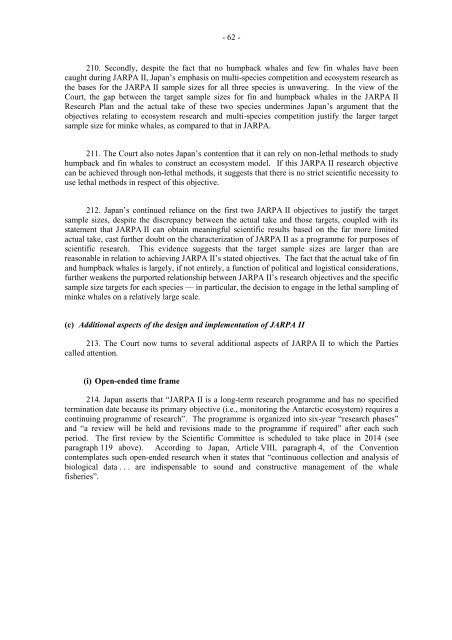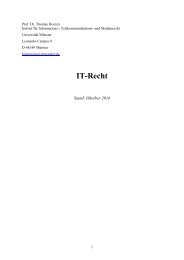3d4yVkKMl
3d4yVkKMl
3d4yVkKMl
Create successful ePaper yourself
Turn your PDF publications into a flip-book with our unique Google optimized e-Paper software.
- 62 -<br />
210. Secondly, despite the fact that no humpback whales and few fin whales have been<br />
caught during JARPA II, Japan’s emphasis on multi-species competition and ecosystem research as<br />
the bases for the JARPA II sample sizes for all three species is unwavering. In the view of the<br />
Court, the gap between the target sample sizes for fin and humpback whales in the JARPA II<br />
Research Plan and the actual take of these two species undermines Japan’s argument that the<br />
objectives relating to ecosystem research and multi-species competition justify the larger target<br />
sample size for minke whales, as compared to that in JARPA.<br />
211. The Court also notes Japan’s contention that it can rely on non-lethal methods to study<br />
humpback and fin whales to construct an ecosystem model. If this JARPA II research objective<br />
can be achieved through non-lethal methods, it suggests that there is no strict scientific necessity to<br />
use lethal methods in respect of this objective.<br />
212. Japan’s continued reliance on the first two JARPA II objectives to justify the target<br />
sample sizes, despite the discrepancy between the actual take and those targets, coupled with its<br />
statement that JARPA II can obtain meaningful scientific results based on the far more limited<br />
actual take, cast further doubt on the characterization of JARPA II as a programme for purposes of<br />
scientific research. This evidence suggests that the target sample sizes are larger than are<br />
reasonable in relation to achieving JARPA II’s stated objectives. The fact that the actual take of fin<br />
and humpback whales is largely, if not entirely, a function of political and logistical considerations,<br />
further weakens the purported relationship between JARPA II’s research objectives and the specific<br />
sample size targets for each species — in particular, the decision to engage in the lethal sampling of<br />
minke whales on a relatively large scale.<br />
(c) Additional aspects of the design and implementation of JARPA II<br />
213. The Court now turns to several additional aspects of JARPA II to which the Parties<br />
called attention.<br />
(i) Open-ended time frame<br />
214. Japan asserts that “JARPA II is a long-term research programme and has no specified<br />
termination date because its primary objective (i.e., monitoring the Antarctic ecosystem) requires a<br />
continuing programme of research”. The programme is organized into six-year “research phases”<br />
and “a review will be held and revisions made to the programme if required” after each such<br />
period. The first review by the Scientific Committee is scheduled to take place in 2014 (see<br />
paragraph 119 above). According to Japan, Article VIII, paragraph 4, of the Convention<br />
contemplates such open-ended research when it states that “continuous collection and analysis of<br />
biological data . . . are indispensable to sound and constructive management of the whale<br />
fisheries”.



